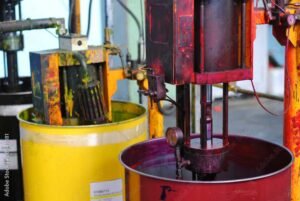Introduction to Mithila Paint Manufacturing Industry in Rajasthan
Mithila art, a vibrant traditional form of painting originating from the Mithila region of India, holds significant cultural relevance that extends beyond mere aesthetics. With roots traced back to ancient times, this art form was initially created by women to adorn the walls of their homes, using natural dyes and pigments. The paintings often depicted mythological narratives, folklore, and social customs, encapsulating the essence of the local culture.
One notable characteristic of Mithila paints is their intricate detailing and vivid colors, which are achieved through the use of organic materials. Motifs often include elements of nature, such as flowers, animals, and celestial bodies, reflecting the artists’ closeness to the environment. The themes presented in these works are deeply symbolic, conveying a range of emotions and ideas that resonate with viewers on multiple levels. The unique style is not only recognized for its beauty but also for its storytelling capacity, communicating significant messages about life, spirituality, and community.
Over time, Mithila art has evolved, adapting to modern influences while maintaining its traditional essence. Contemporary artists have extended the scope of Mithila paintings, incorporating new mediums such as canvas and creating commercial products like textiles, home décor items, and other art forms. This shift has enabled the once regional art form to gain international attention, allowing Mithila paints to find a place in galleries and exhibitions worldwide. In exploring the Mithila art scene, one can witness a convergence of history and modernity, showcasing the resilience of cultural heritage while promoting creativity and innovation.

The Rise of Mithila Paint Manufacturing in Rajasthan
The emergence of Mithila paint manufacturing in Rajasthan marks a significant development within the traditional art sector. Historically associated with the Mithila region of Bihar, Mithila paints have gained recognition and marketability beyond their original geographic bounds. This transformation can be attributed to a confluence of factors that have facilitated the growth of a formal industry surrounding this art form in Rajasthan.
One of the primary drivers of this rise is the economic opportunity it presents for local artisans. Many families in Rajasthan have turned to Mithila painting as a source of income, leveraging their artistic skills to create a sustainable livelihood. As artisans produce unique pieces reflecting the rich cultural heritage of Mithila, they open doors for both local and international markets. Furthermore, the increasing fusion of traditional and contemporary designs has attracted a broader customer base, enhancing the demand for Mithila paints.
Government support has also played a crucial role in this industry’s growth. Various initiatives and programs have been enacted to promote traditional arts and crafts, increasing access to resources, training, and funding for artisans specializing in Mithila painting. With government backing, artisans are better positioned to develop their skills and market their work effectively, ensuring the longevity of this artistic tradition.
In addition, non-governmental organizations (NGOs) and cooperatives have emerged as prominent advocates for Mithila art in Rajasthan. These groups work diligently to provide artisans with the necessary tools to succeed, including marketing assistance and training workshops. By fostering community partnerships and creating platforms for artisans to showcase their work, NGOs have cultivated an environment conducive to the growth of Mithila paint manufacturing.
As a result, Rajasthan is witnessing a renaissance of Mithila arts that integrates traditional practices with modern business models, ensuring that this vibrant cultural expression continues to flourish.
The Process of Mithila Paint Manufacturing
The manufacturing of Mithila paints is a meticulous process that intertwines traditional techniques with innovative practices. Central to this art form is the sourcing of natural materials, which exemplify the artistry and cultural heritage of the Mithila region. Local artisans primarily use pigments derived from natural sources, such as plants, minerals, and even charcoal, to create vibrant colors. This commitment to natural ingredients not only enhances the aesthetic appeal of the paints but also ensures sustainability in production.
Once the materials are sourced, artisans move on to the preparation of colors. This step involves grinding the natural pigments, often mixing them with a binding agent extracted from natural substances, such as cow dung or clay. The resulting consistency is crucial, as it determines the texture and application of the paint. Artisans skillfully create varying shades and hues, a process that demands both precision and an understanding of color theory derived from traditional knowledge passed down through generations.
After preparing the colors, the artisans employ distinct techniques to bring their visions to life on the canvas or paper. The craft of Mithila painting is characterized by intricate designs featuring motifs inspired by nature, mythology, and daily life. Traditional methods involve using fine brushes made from twigs or hair, which allow for detailed work. Moreover, many craftsmen incorporate modern innovations, such as synthetic colors or improved tools, to enhance their capabilities while still adhering to their artistic roots.
This blending of time-honored practices with contemporary enhancements underscores the intricate craftsmanship involved in the creation of Mithila paints. Each piece reflects the dedication of the artisans, showcasing not just skill but also a deep cultural significance, thereby enriching the vibrant tapestry of Indian art. As such, the Mithila paint manufacturing process exemplifies a rich tradition that continues to thrive amidst changing times.

Artisans: The Heart of Mithila Paint Industry
The Mithila paint manufacturing industry thrives primarily due to the artisans whose skills and passion breathe life into this traditional art form. Originating from the Mithila region of Bihar, these artists, often referred to as Mithila painters, are instrumental in creating vibrant, intricate designs that depict cultural narratives and folklore. The craftsmanship involved in Mithila paints is not merely a technique but a cultural heritage passed down through generations, requiring years of dedication and training to master.
Many artisans begin their journey in childhood, often learning the intricacies of the craft from family members. The artwork demands a thorough understanding of the traditional symbols, colors, and themes that characterize Mithila paintings. While the traditional materials, such as natural dyes and handmade paper, are integral to the authenticity of Mithila paints, artisans are increasingly incorporating modern techniques and mediums to reach broader audiences.
Despite their critical role in the industry, many artisans face significant socio-economic challenges. Fluctuating incomes, lack of access to markets, and inadequate training resources are common obstacles that hinder their ability to thrive. Furthermore, there exists a disparity in the recognition and remuneration they receive compared to the value of their art. Some renowned Mithila artists have made strides in addressing these issues by connecting with NGOs and cooperatives that advocate for their rights, provide training, and improve market access.
The stories of these artisans are often marked by resilience and creativity. For instance, Sita Rai, a prominent Mithila painter, has not only excelled in her craft but has also worked tirelessly to elevate the status of women artisans in her community. Through exhibitions and workshops, she aims to foster a greater appreciation for Mithila paints, showcasing not just the beauty of her work, but also the deeper narratives that underlie her culture.

Market Trends and Consumer Demand
The market for Mithila paints and its associated products has witnessed substantial growth in recent years, driven by a resurgence of interest in traditional crafts and a shift in consumer preferences towards handmade items. Mithila paintings, known for their intricate designs and vibrant colors, have found their way into various sectors, including home decor, fashion, and gifting. This increasing demand reflects a broader trend where consumers are leaning towards unique, artisanal products that tell a story and resonate with cultural heritage.
Home decor has become a particularly lucrative avenue for Mithila art. Consumers are increasingly decorating their living spaces with hand-painted wall hangings, tableware, and textiles that incorporate Mithila designs, finding them not only aesthetically pleasing but also meaningful. The integration of Mithila themes into modern furniture and accessories has opened new market segments, appealing to both domestic and international buyers.
As social media platforms have gained prominence, they have played a pivotal role in the marketing and selling of Mithila paintings. Artists and artisans are leveraging digital channels to reach a broader audience, showcasing their work to a global market that values authenticity and craftsmanship. Platforms such as Instagram and Etsy have emerged as vital tools for promoting Mithila art, allowing consumers to connect with the creators and learn about the cultural significance behind each piece.
Demographic changes also influence consumer demand. Younger generations, especially those who value sustainability and cultural heritage, are more inclined towards purchasing handmade items like Mithila paintings. This shift not only highlights the relevance of traditional art forms in contemporary consumer markets but also encourages the preservation of this unique craft. As Mithila art continues to evolve and adapt to modern elements while retaining its core traditions, the potential for growth in this industry appears promising.

Sustainability and Ethical Practices in Mithila Paint
The Mithila paint manufacturing industry in Rajasthan exemplifies a commitment to sustainability and ethical practices through several initiatives aimed at minimizing its ecological footprint. At the heart of this industry lies the use of natural materials and eco-friendly methods that not only resonate with traditional values but also actively contribute to environmental conservation. Artisans engage in using locally sourced, non-toxic pigments derived from plants, minerals, and other organic substances. This reliance on natural resources is paramount in ensuring that the paint remains biodegradable and reduces dependence on synthetic chemicals that are damaging to the environment.
In addition to using sustainable materials, the Mithila paint industry actively promotes ethical sourcing practices that empower local communities. By sourcing raw materials from local farmers and artisans, the industry supports the local economy while fostering a sense of community engagement. This approach not only provides fair compensation to those involved in the supply chain but also promotes traditional methods that have been passed down through generations. The preservation of cultural heritage is a fundamental aspect of these practices, as artisans maintain the unique artistic styles that define Mithila paints while benefiting economically from their craft.
Moreover, many workshops and organizations within the Mithila paint industry are adopting sustainable business models that address ecological concerns. By focusing on sustainable production techniques, such as using renewable energy sources and reducing waste, these practices help to minimize the environmental impact associated with manufacturing. Through education and awareness, local artisans are being trained to incorporate sustainable practices into their work, ensuring that Mithila paint continues to thrive while upholding an ethics-driven approach that respects both the planet and its people. In conclusion, the sustainability and ethical practices inherent to the Mithila paint industry reflect a vibrant intertwining of art, culture, and environmental stewardship, making it a model worth emulating in creative industries globally.
Challenges Facing the Mithila Paint Industry
The Mithila paint manufacturing industry, deeply rooted in the cultural heritage of India, especially in the regions of Rajasthan, faces a multitude of challenges that threaten its sustainability and growth. One significant issue is the intense competition posed by mass-produced art. In a market dominated by affordable and widely available printed art, artisans often struggle to showcase the value of their handcrafted Mithila paintings. The uniqueness and labor-intensive nature of these artworks are frequently overshadowed by the convenience of cheaper alternatives, leading to declining sales for traditional artists.
Another critical challenge arises from the gradual loss of traditional skills among the younger generation. Many artisans find it difficult to pass down the intricate techniques and cultural stories that define Mithila paints, as contemporary influences and modern lifestyles divert attention away from this traditional craft. Without effective preservation efforts, the rich knowledge and skills associated with Mithila painting risk fading, further complicating the continuity of this art form.
Moreover, economic hardships contribute significantly to the difficulties faced by the Mithila paint industry. Some artisans often live in rural areas with limited access to markets and financial resources, making it challenging to sustain their livelihoods through their craft. The lack of adequate infrastructure and support from both governmental and non-governmental organizations exacerbates these conditions, hindering the industry’s development. The phenomenon of globalization has compounded these issues, as overwhelming exposure to foreign art forms can dilute local traditions, making it crucial to advocate for the promotion of Mithila paintings on both national and international platforms.
Addressing these challenges is essential for the survival of the Mithila paint industry. Strategies to enhance visibility, provide economic support, and ensure knowledge transfer are vital in maintaining the legacy of this exquisite art form.
Promotion and Future Prospects of Mithila Art
The promotion of Mithila art, especially through the medium of mithila paints, has seen significant developments over recent years. Various initiatives, including art exhibitions, fairs, and educational programs, aim to elevate this traditional art form. These events not only provide a platform for indigenous artists but also facilitate the dissemination of knowledge regarding mithila paints, enabling wider appreciation and understanding of this cultural heritage.
One noteworthy avenue for promotion is the integration of technology and social media. Artists and organizations are increasingly utilizing online platforms to showcase their work, share the intricacies of the art form, and connect with potential customers globally. Social media campaigns and virtual exhibitions have made it possible to reach a broader audience, thereby enhancing visibility for Mithila art. As artists navigate this digital landscape, their ability to blend traditional storytelling with contemporary themes through mithila paints captures the interest of new generations.
Collaborations with contemporary artists, designers, and brands also play a critical role in the future of the Mithila paint industry. By partnering with individuals and organizations outside their traditional milieu, Mithila artists can explore innovative design interpretations and expand their market reach. These collaborations can lead to unique product offerings that resonate with modern consumers, thus ensuring the sustainability of Mithila art.
Furthermore, there is immense potential for international recognition. With the growing global market for handmade and artisanal products, Mithila art can appeal to both ethical consumers and collectors. Efforts to secure international exhibitions and participation in art fairs will be fundamental in establishing Mithila paints as a renowned art form. In conclusion, the combined influence of technology, educational initiatives, and collaborations presents a promising future for Mithila art, enabling it to thrive in the contemporary art landscape while preserving its rich cultural significance.


Conclusion: Celebrating Mithila Paint
The Mithila paint manufacturing industry in Rajasthan serves as a testament to the resilience and vibrancy of traditional art forms. This age-old craft, deeply rooted in the cultural heritage of the Mithila region, has transcended geographical boundaries to find its place in contemporary art narratives. The unique characteristics of Mithila paintings, marked by intricate patterns and vibrant colors, reflect not only the artistic prowess of its creators but also the rich tapestry of stories and traditions embedded within these artworks.
In recent years, there has been a growing appreciation for Mithila paints, driving interest among both collectors and art lovers worldwide. As global markets begin to recognize the significance of these handcrafted pieces, local artisans are presented with opportunities to thrive economically while preserving their cultural identity. The Mithila paint industry, therefore, is not merely an economic endeavor but a cultural movement that emphasizes the importance of safeguarding traditional art forms. Initiatives aimed at promoting Mithila paintings encourage artisans to innovate while staying faithful to their roots, ensuring that the art continues to evolve and resonate with new audiences.
However, it is crucial to understand the challenges facing this industry. As urbanization and modernization reshape societal values, supporting initiatives that empower Mithila artists can help maintain the authenticity and sustainability of this craft. Furthermore, educating consumers about the significance of these paintings fosters a deeper appreciation for the skills and stories that each piece embodies. By recognizing and celebrating Mithila paints not only as decorative art but as cultural heritage, we can contribute to the continued relevance of this traditional craft in our contemporary world.
